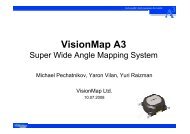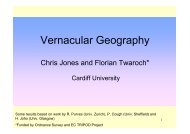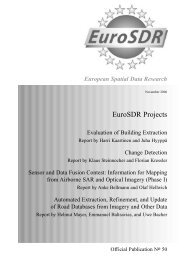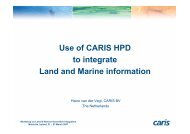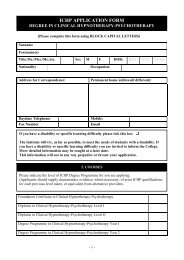European Organization for Experimental ... - Host Ireland
European Organization for Experimental ... - Host Ireland
European Organization for Experimental ... - Host Ireland
You also want an ePaper? Increase the reach of your titles
YUMPU automatically turns print PDFs into web optimized ePapers that Google loves.
2.4.6 Tracks.<br />
The alignment of tracks was very easy to capture, but problems arose when trying to differentiate<br />
between tracks and small metalled roads.<br />
2.4.7 Vegetation.<br />
General vegetation was easy to depict although the actual nature of the vegetation is not<br />
easy to identify. This imagery would be suitable <strong>for</strong> mapping at scales ranging from 1:2500<br />
to 1:50,000.<br />
2.4.8 Forestry limits.<br />
These were very easy to capture. Species and type of tree were a little more difficult to<br />
determine. However, it is possible to distinguish between wholly coniferous or wholly nonconiferous<br />
areas, indicating that this imagery would be suitable <strong>for</strong> 1:10,000 scales mapping<br />
and smaller.<br />
2.4.9 Electricity poles / pylons.<br />
Actual poles are difficult to identify, but the identification is greatly helped by shadows<br />
caused by the shallow sun angle. Pylons are a bit easier to identify. However, in both types<br />
the actual electricity lines cannot be seen, thus making the alignment of the whole line<br />
through the image quite difficult to follow.<br />
Pylons and alignment could be captured <strong>for</strong> 1:10,000 mapping and smaller, while electricity<br />
poles would require field completion/verification<br />
2.4.10 Water detail.<br />
Lakes and ponds were easily identified and captured. Lakes would be acceptable <strong>for</strong><br />
1:10,000 mapping and smaller. Small ponds would require confirmation on the ground.<br />
The capture process would be helped using multispectral or pan-sharpened imagery.<br />
2.4.11 Rivers and streams.<br />
Rivers are quite easy to detect, but smaller streams are difficult to differentiate from paths.<br />
Multispectral, or pan-sharpened, imagery would make this task easier. It is also difficult to<br />
determine the width of a stream; and it is thought that stereo imagery would help in this<br />
process. The capture of rivers from this imagery would be acceptable <strong>for</strong> 1:10,000 mapping<br />
and smaller, but streams would require field completion to get a true picture of the topographic<br />
feature.<br />
2.5 Comment on results<br />
The identification of all of the features considered in this research would be improved<br />
greatly if stereo imagery was used. Previous studies at the Ordnance Survey (Ridley et al.<br />
1997), analysing sub-sampled 1m aerial imagery, concluded that stereo imagery would<br />
increase identification by 20%. Although stereo data was not available <strong>for</strong> this project,<br />
stereo IKONOS imagery was viewed by kind permission of Professor Dowman at UCL, and<br />
39



